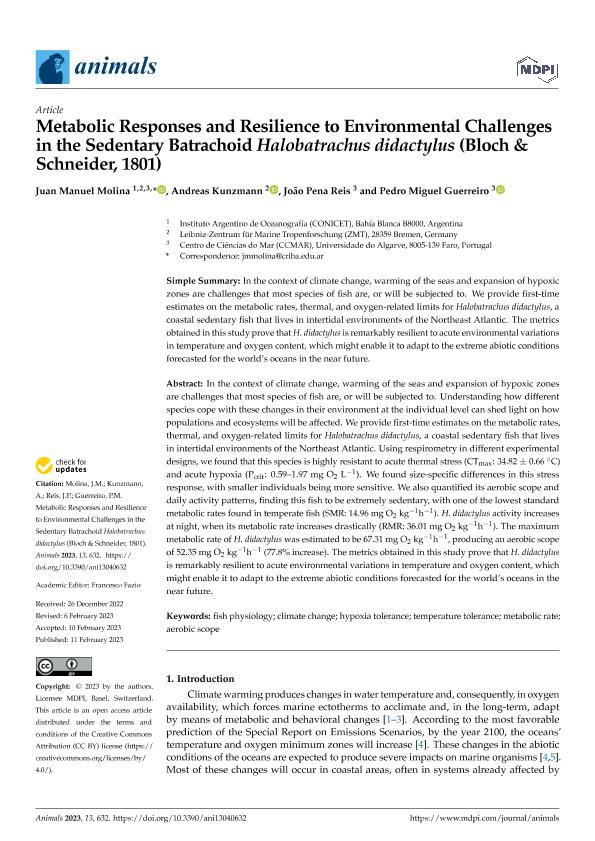Mostrar el registro sencillo del ítem
dc.contributor.author
Molina, Juan Manuel

dc.contributor.author
Kunzmann, Andreas
dc.contributor.author
Pena Reis, João
dc.contributor.author
Guerreiro, Pedro Miguel
dc.date.available
2024-04-19T09:43:59Z
dc.date.issued
2023-02-11
dc.identifier.citation
Molina, Juan Manuel; Kunzmann, Andreas; Pena Reis, João; Guerreiro, Pedro Miguel; Metabolic Responses and Resilience to Environmental Challenges in the Sedentary Batrachoid Halobatrachus didactylus (Bloch & Schneider, 1801); Multidisciplinary Digital Publishing Institute; Animals; 13; 4; 11-2-2023; 1 - 21
dc.identifier.issn
2076-2615
dc.identifier.uri
http://hdl.handle.net/11336/233498
dc.description.abstract
In the context of climate change, warming of the seas and expansion of hypoxic zones are challenges that most species of fish are, or will be subjected to. Understanding how different species cope with these changes in their environment at the individual level can shed light on how populations and ecosystems will be affected. We provide first-time estimates on the metabolic rates, thermal, and oxygen-related limits for Halobatrachus didactylus, a coastal sedentary fish that lives in intertidal environments of the Northeast Atlantic. Using respirometry in different experimental designs, we found that this species is highly resistant to acute thermal stress (CTmax: 34.82 ± 0.66 ◦C) and acute hypoxia (Pcrit: 0.59–1.97 mg O2 L−1). We found size-specific differences in this stress response, with smaller individuals being more sensitive. We also quantified its aerobic scope and daily activity patterns, finding this fish to be extremely sedentary, with one of the lowest standard metabolic rates found in temperate fish (SMR: 14.96 mg O2 kg−1h−1). H. didactylus activity increases at night, when its metabolic rate increases drastically (RMR: 36.01 mg O2 kg−1h−1). The maximum metabolic rate of H. didactylus was estimated to be 67.31 mg O2 kg−1h−1, producing an aerobic scope of 52.35 mg O2 kg−1h−1 (77.8% increase). The metrics obtained in this study prove that H. didactylus is remarkably resilient to acute environmental variations in temperature and oxygen content, which might enable it to adapt to the extreme abiotic conditions forecasted for the world’s oceans in the near future.
dc.format
application/pdf
dc.language.iso
eng
dc.publisher
Multidisciplinary Digital Publishing Institute

dc.rights
info:eu-repo/semantics/openAccess
dc.rights.uri
https://creativecommons.org/licenses/by/2.5/ar/
dc.subject
Fish Physiology
dc.subject
Climate Change
dc.subject
Hypoxia Tolerance
dc.subject
Temperature Tolerance
dc.subject
Metabolic Rate
dc.subject
Eerobic Scope
dc.subject.classification
Otros Tópicos Biológicos

dc.subject.classification
Ciencias Biológicas

dc.subject.classification
CIENCIAS NATURALES Y EXACTAS

dc.title
Metabolic Responses and Resilience to Environmental Challenges in the Sedentary Batrachoid Halobatrachus didactylus (Bloch & Schneider, 1801)
dc.type
info:eu-repo/semantics/article
dc.type
info:ar-repo/semantics/artículo
dc.type
info:eu-repo/semantics/publishedVersion
dc.date.updated
2024-04-17T13:07:15Z
dc.journal.volume
13
dc.journal.number
4
dc.journal.pagination
1 - 21
dc.journal.pais
Suiza

dc.description.fil
Fil: Molina, Juan Manuel. Consejo Nacional de Investigaciones Científicas y Técnicas. Centro Científico Tecnológico Conicet - Bahía Blanca. Instituto Argentino de Oceanografía. Universidad Nacional del Sur. Instituto Argentino de Oceanografía; Argentina
dc.description.fil
Fil: Kunzmann, Andreas. Leibniz-Zentrum für Marine Tropenforschung; Alemania
dc.description.fil
Fil: Pena Reis, João. Universidad de Algarve; Portugal
dc.description.fil
Fil: Guerreiro, Pedro Miguel. Universidad de Algarve; Portugal
dc.journal.title
Animals

dc.relation.alternativeid
info:eu-repo/semantics/altIdentifier/url/https://www.mdpi.com/2076-2615/13/4/632
dc.relation.alternativeid
info:eu-repo/semantics/altIdentifier/doi/https://doi.org/10.3390/ani13040632
Archivos asociados
